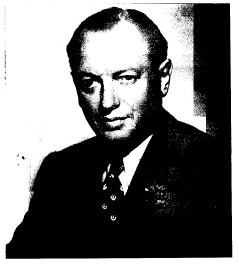Myron Prinzmetal
[ Table of Contents ] Profiles in Cardiology
This section edited by J. Willis Hurst, MD.
By
CLARENCE M. AGRES
Myron Prinzmetal was born in Buffalo, New York, on February 8, 1908, the second son of Anna and Harry Prinzmetal. The family moved to Los Angeles where the death of Prinzmetal’s invalid father forced his impoverished mother to boarding house for subsistence. Despite these hard beginnings, his brother, Isadore, became an outstanding lawyer, while Myron would leave his name in the annals of medical science.
Myron attended Roosevelt High School in Los Angeles and received a B.A. degree from U.C.L.A. in the year of the great depression. He won an M.A. degree in pharmacy at the University of California in San Francisco and, in 1933, his M.D. degree. While still a student he was a co-author of a paper on the effect of broncho-constricting drugs on intrapleural pressure, the first of over 165 medical publications during his brilliant career.
Following Dr. Prinzmetal's internship in San Francisco, he went to Bames Hospital at Washington University in St. Louis for his residency. By the time he had finished a fellowship from the National Research Council at Harvard, he had already published 20 mom articles on pulmonary disease, ventricular tachycanlia, emphysema, and his first papers on electrocardiography. He worked with W.B. Kountz and H.L. Alexander in a joint publication on emphysema.

He became Sutro Fellow at Mt. Sinai Hospital in New York City in 1935. Eleven more studies, including his first publication on hypertension, led to his appointment as Fellow of the American College of Physicians at University College, London. There he worked with Dr. G.W Pickering on renin. After one year, he became Fellow of the Dazian Foundation, returning to California at U.S.C. where he continued his studies on hypertension. By 1939 he was working in his laboratory at Cedars of Lebanon Hospital and beginning private practice.
With his first wife (later divorced) Blanche Keiler he had four children, Byron, Anita, William, and Cynthia.
He did not serve in the U.S. Armed Forces during the Second World War because of loss of sight of one eye, but he continued to publish papers on hypertension, some with the noted pathologist and his dear friend, the late Dr. John L. Tragerman. For the war effort he turned to the study of shock due to muscle trauma and burns. A total of 23 publications came of this effort. At the end of the war, he began his first studies on the coronary circulation. With Dr. Clarence Agress, he was the first on the West Coast to use Chapman and Evans’ discovery of the efficacy of radioactive iodine in the treatment of Graves disease. In 1950 he began his work on the auricular arrhythmias, making use of high-speed cine-electrocardiography. Paper after paper on atrial and ventricular arrhythmias saw publication during this period. These included the conformation of the circus movement in atrial flutter, first suggested by Sir Thomas Lewis; the mechanism of ventricular activity; the origin of the RS-T segment changes in acute myocardial infarction; and the nature of spontaneous atrial fibrillation.
In 1959, with Dr. Rexford Kennamer and others, he published their first observations on the variant form of angina pectoris, a landmark report that was to ensure him a place in the annals of medicine. This type of angina became known as "Prinzmetal’s angina." Many other articles and several books were to follow until illness forced him to retire from research and practice.
Dr. Prinzmetal published 165 articles or more. His interest ranged from disease of the lung, kidneys, and peripheral vascular disease to cardiac arrhythmias, circulatory shock, hypertension, and coronary syndromes. (I am listing only four of his articles in the references to this paper).
In addition to belonging to many leading medical societies, Dr. Prinzmetal was on the editorial hoard of the American Heart Journal and the American Journal of Cardiology. He was a prime moving force in the formation of the American College of Cardiology and the development of cardiology on the West Coast. He was the recipient of numerous awards and was a guest lecturer in many foreign countries, especially England, where he gave the Sir Thomas Lewis Memorial Lecture.
Dr. Prinzmetal died on January 8, 1987. He will be remembered also for his rare book collections which include all four folio editions of Shakespeare and a first edition of Harvey’s De Motu Cordis—the only one not owned by a museum. He restored to the Royal College of Physicians in London the only known portrait of Harvey. Most outstanding was his collection of the memorabilia of his idol, Sir William Osler. His knowledge and love of classical music should not be forgotten.
His spirit will live on in his inspiration of the young men who had the privilege of working with him in the laboratory and in private practice to make important contributions to research and the advancement of cardiology.
Acknowledgments
A portion of this article appeared in the Cedars Sinai Medical Center Medical Staff News. It is reproduced here with permission.
References
Prinzmetal M, Corday E, Spritzler RI, Flieg W: Radiocardiography and its clinical applications. JAm MedAssoc 139,617—622(1949)
Prinzmetal M, Corday E, Oblath RW, Kruger HE, Brill IC, Fields J, Kennarner SR, Osborne JA, Smith LA, Sellers AL, Flieg W, Fanston E: Auracular flutter. AmJMed 146, 1275—1281 (1951) Prinzmetal M, Kennarner R, Merliss R, WadaT, BorN: Angina pectoris. I. A variant form of angina pectoris. (Preliminary report). AmJMed 27,375—388(1959)
Prinzmetal M, Ekmekci A, Kennamer R, Kwoczynski JK, Shubin H, Toyoshima H: Variant form of angina pectoris, previously undelineated syndrome. JAm MedAssoc. 174, 1794—1800(1960)